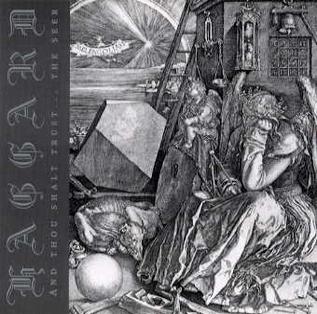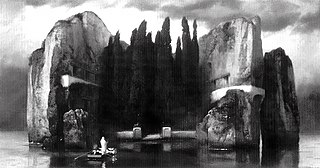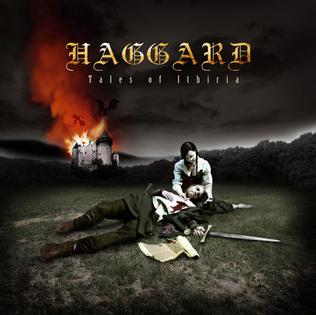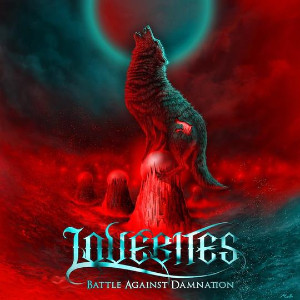
Sergei Vasilyevich Rachmaninoff was a Russian composer, virtuoso pianist, and conductor. Rachmaninoff is widely considered one of the finest pianists of his day and, as a composer, one of the last great representatives of Romanticism in Russian classical music. Early influences of Tchaikovsky, Rimsky-Korsakov, and other Russian composers gave way to a thoroughly personal idiom notable for its song-like melodicism, expressiveness, dense contrapuntal textures, and rich orchestral colours. The piano is featured prominently in Rachmaninoff's compositional output and he used his skills as a performer to fully explore the expressive and technical possibilities of the instrument.
Symphonic black metal is a subgenre of black metal that emerged in the 1990s and incorporates symphonic and orchestral elements.

The Rhapsody on a Theme of Paganini, Op. 43, is a concertante work written by Sergei Rachmaninoff for piano and orchestra, closely resembling a piano concerto, all in a single movement. Rachmaninoff wrote the work at his summer home, the Villa Senar in Switzerland, according to the score, from 3 July to 18 August 1934. Rachmaninoff himself, a noted performer of his own works, played the piano part at the piece's premiere on 7 November 1934, at the Lyric Opera House in Baltimore, Maryland, with the Philadelphia Orchestra conducted by Leopold Stokowski.

Haggard is a German symphonic metal band founded in 1989. The group combines classical music and early music with death doom metal.
Symphonic metal is a cross-generic style designation for the symphonic subsets of heavy metal music subgenres. It is used to denote any metal band that makes use of symphonic or orchestral elements. The style features the heavy drums and guitars of metal with different elements of orchestral classical music, such as symphonic instruments, choirs and sometimes a full orchestra, or just keyboard orchestration.

And Thou Shalt Trust... the Seer is the first full-length album by the German symphonic metal band Haggard. It was released on 15 October 1997 by Last Episode. The painting of the cover is Melencolia I by Albrecht Dürer. The album was re-released as a vinyl record in 2008 by Nattvind Records.

Eppur si muove is the third full-length album by the German symphonic metal band Haggard. It was released on 26 April 2004 by Drakkar Entertainment.

Awaking the Gods: Live in Mexico is the first live album by the German symphonic metal band Haggard. It was released on 24 September 2001 by Drakkar Entertainment. It was filmed at Teatro Ferrocarrilero in Mexico City during the tour for the Awaking the Centuries album. The DVD contains footage from Teotihuacan between the songs.

Symphonic Dances, Op. 45, is an orchestral suite in three movements completed in October 1940 by Russian composer Sergei Rachmaninoff. It is his final major composition, and his only piece written in its entirety while living in the United States.

The Rock, Op. 7 (Utyos) is a fantasia or symphonic poem for orchestra written by Sergei Rachmaninoff in the summer of 1893. It is dedicated to Nikolai Rimsky-Korsakov.

Isle of the Dead is the best-known painting of Swiss Symbolist artist Arnold Böcklin (1827–1901). Prints were very popular in central Europe in the early 20th century—Vladimir Nabokov observed in his 1936 novel Despair that they could be "found in every Berlin home".

Isle of the Dead, Op. 29, is a symphonic poem composed by Sergei Rachmaninoff, written in the key of A minor. The piece was inspired by a black and white reproduction of Arnold Böcklin's painting Isle of the Dead, which he saw in Paris in 1907. He composed the work from January to March of 1909, but later made numerous revisions, including cuts.

Tales of Ithiria is the fourth studio album by the German symphonic metal band Haggard. Previously known under its work title A Dark Winter's Tale, this album breaks the band's habit of writing about historical characters and events. Instead, it tells a fictional, medieval-themed story written by Haggard's songwriter Asis Nasseri. The album includes a cover version of the song "Hijo de la Luna", originally written by José María Cano and performed by his own band, Spanish Pop group Mecano. However, his authorship of the song is not acknowledged in the CD's booklet, instead being referred to as "Traditional" music and lyrics.
Polichinelle is French for the Commedia dell'arte character Pulcinella.

Sergei Rachmaninoff's Polka de W.R. is a virtuoso piano arrangement of Franz Behr's Lachtäubchen (Scherzpolka) in F major.

Manuela Kraller is a German spinto soprano singer. She is best known as the former lead singer of symphonic metal band Xandria from late 2010 until late 2013. She was formerly one of the soprano vocalists in the symphonic metal band Haggard. She now has a project that strays away from the metal scene and more of a classical style instead that's called "Valkea Valo" with her friend Tobias Gut.
Gaby Koss is a German classically trained soprano who has collaborated with metal and rock acts such as Haggard, Nota Profana and Equilibrium. She is the front singer of the bands Nota Profana and Theatre of the Night. She also has her own ensemble of renaissance, baroque and medieval folk music, Cantus Lunaris. In 2014, she started another band that goes by the name of Diskelion.

Sergei Vasilievich Rachmaninoff (1873–1943) was a Russian composer, virtuoso pianist, and conductor. Rachmaninoff is widely considered one of the finest pianists of his day and, as a composer, one of the last great representatives of Romanticism in Russian classical music.

Battle Against Damnation is the second EP by Japanese power metal band Lovebites. The EP was released in Japan on June 6, 2018 by Victor Entertainment, and in Europe and North America two days later by JPU Records. It reached number 20 on the Oricon chart and number 24 on Billboard Japan.














